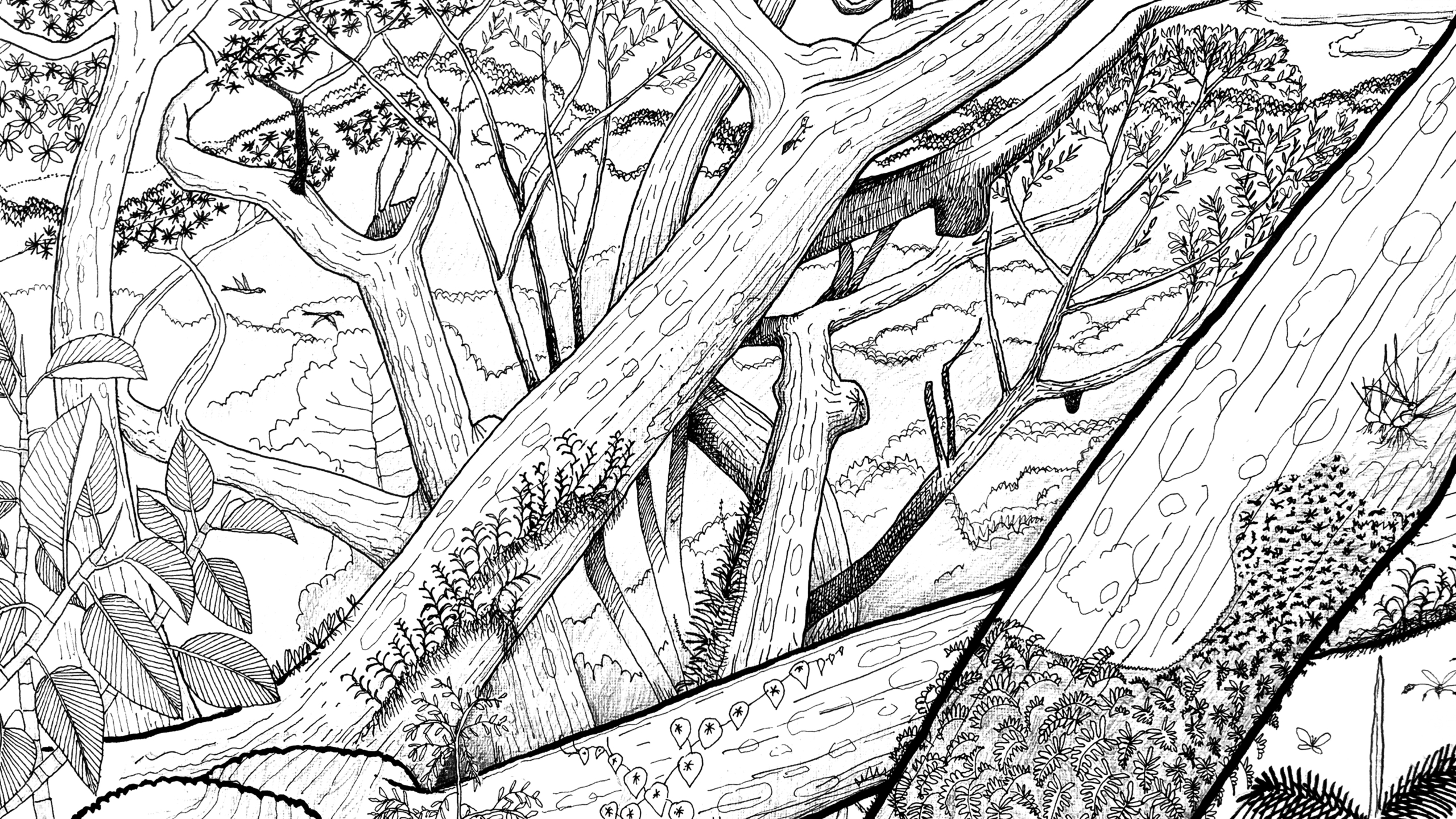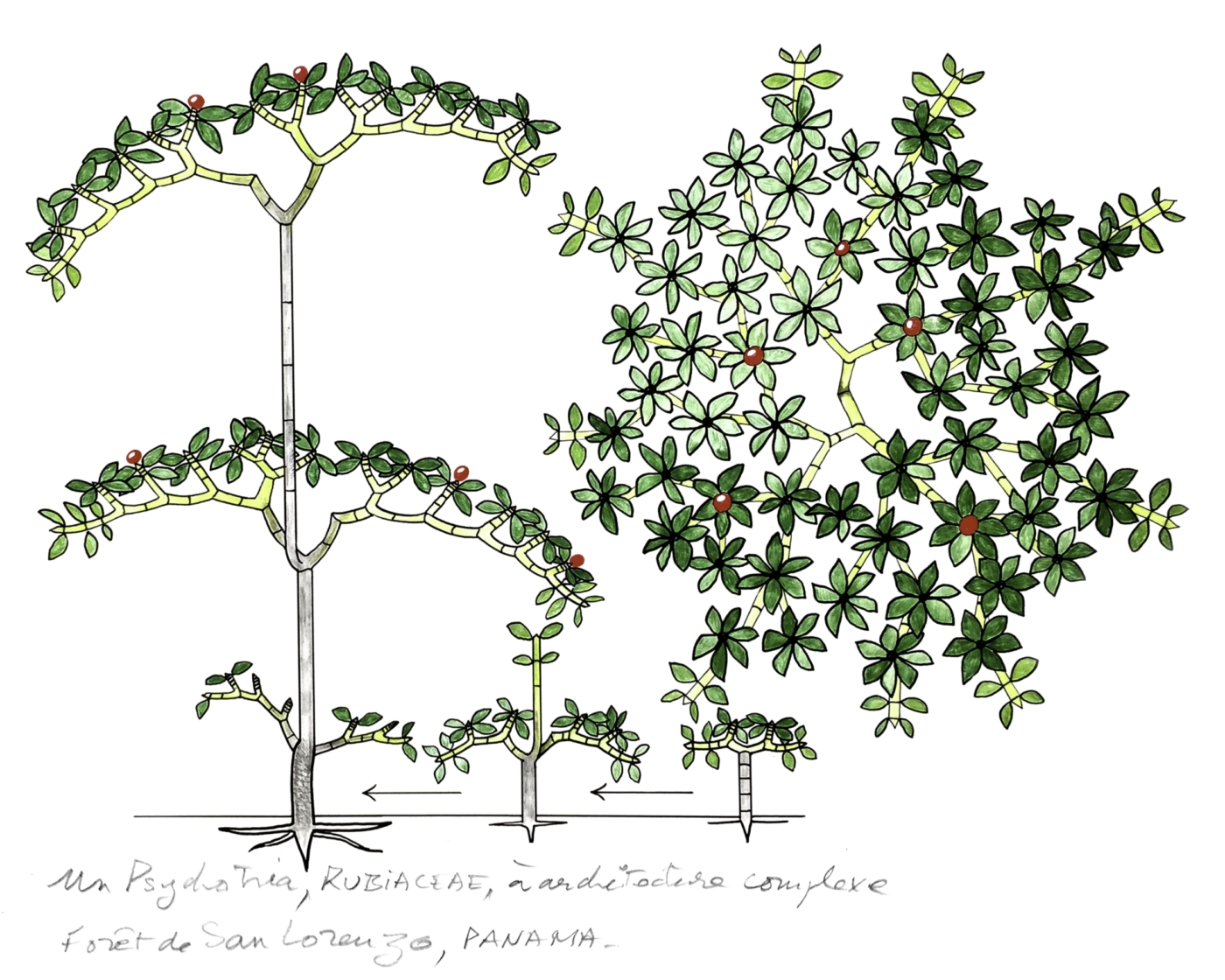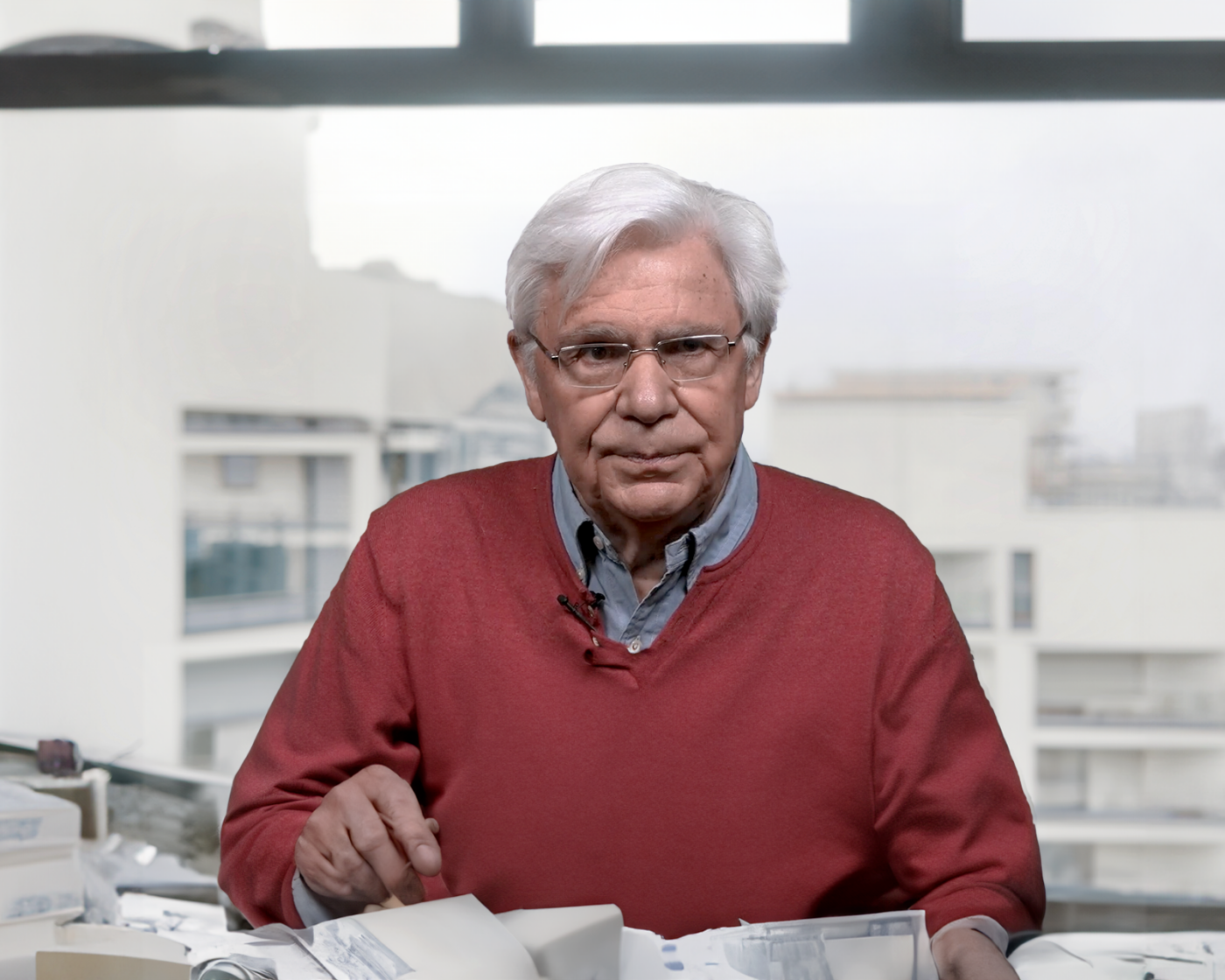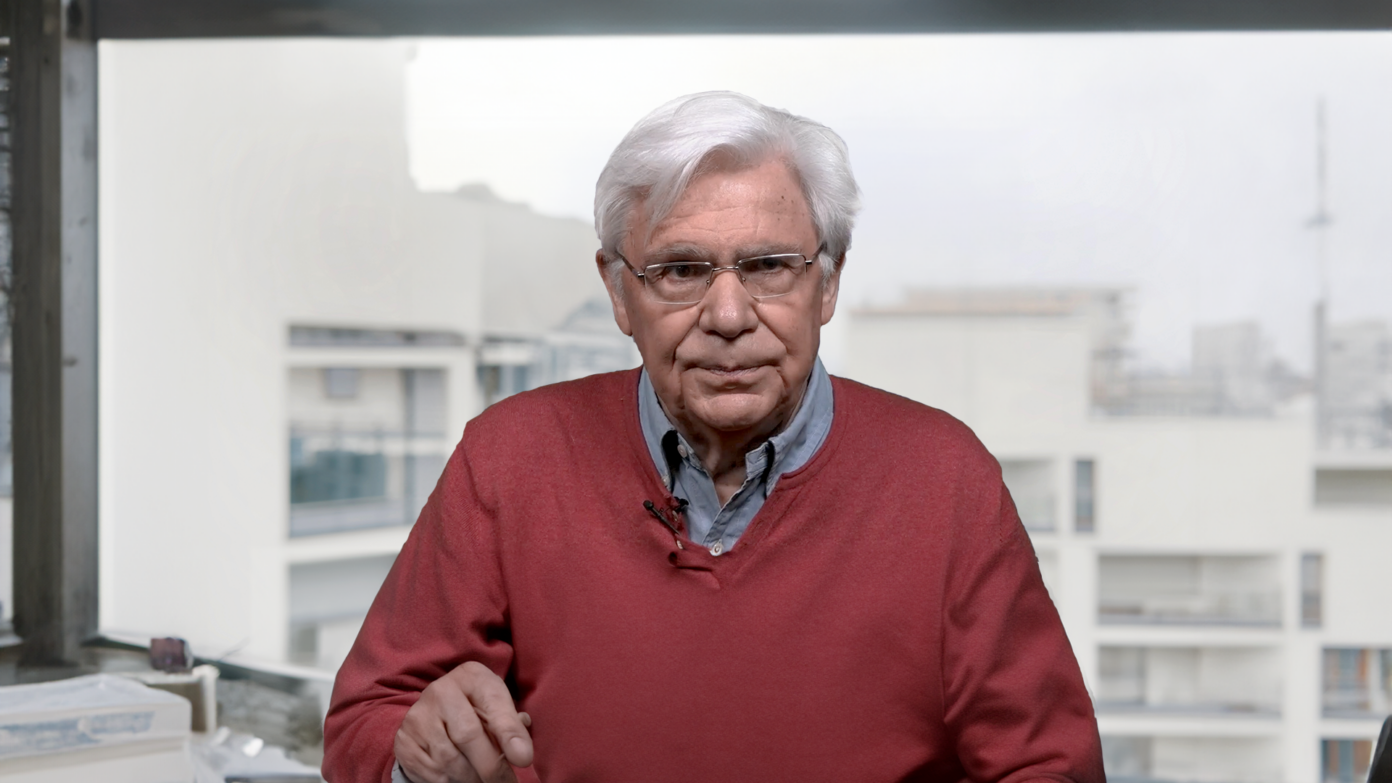Could you tell us how you came up with the concept of “plant architecture” ?
In order to identify a plant in a temperate country such as France, we refer to the shape of its flowers or its fruits, and ideally both. But after my studies, I went to Equatorial Africa, where I faced the limits of this method, given that it was impossible for me to observe the fruits or flowers of tall trees. There was always some debris on the ground of course, but the key features were located more than sixty meters up, restricting the possibilities for conventional visual identification. I then noticed that in the undergrowth, there were younger trees with very characteristic traits. I therefore decided to use them to study and identify the taller trees. Plant architecture came from this idea of referring to these two-meter high specimens, which were easier to observe. I sat at the foot of trees to observe their architectures and started drawing them, which allowed me to identify models.
All this is exclusively graphical, and is best explained through drawing. First comes branch orientation, which is either vertical or horizontal. This may sound foolish, but that’s already a lot. Then there’s growth, which is either continuous or rhythmic. In countries such as France, growth is necessarily rhythmic, given that it ceases every winter, whereas it is continuous in the tropics. Add to that the position of the flowers : if they are terminal, that is, borne at the very end of the axis, and the axis cannot then continue growing, then growth can only happen through secondary buds acting as relays. If the flowers grow sideways, then the axis can continue growing. Fifteen minutes in a forest is enough to observe all of this, which seems very simple, but this provides the basis for highly productive combinations. Obviously, we can only see what we’re looking for, otherwise we see other things, or nothing at all. My work is sometimes criticized on the basis that the research could have been carried out during the seventeenth century. This is perfectly true, and a good illustrator could have made similar observations at the time. Some did by the way, but only in a marginal fashion. It’s simple work, but I happen to be the first to have done it.
My botany is somewhat unusual, because my subject matter is primary equatorial forests. As a biologist, I have always been interested in places that are teeming with life, and life is at its most abundant in tropical forests, especially in the treetops, on the canopy, where the light is. At a height of sixty meters, you can hear the forest brimming with life, much more than in the undergrowth, which is more austere and darker. I spent many years trying to find a solution to go and work up there. This prompted me to launch Opération Canopée with three colleagues. We developed a most peculiar device we called the Radeau des Cimes (Treetop Raft) and with it, we explored equatorial rainforest canopies for almost thirty years. This was my guiding theme during all these years : the more life there is, the better for me. In that respect, the divide between botany and zoology is somewhat outdated, given that one needs the other. A zoologist with no interest in what animals eat wouldn’t understand much. Likewise, a botanist that would fail to pay attention to the animals pollinating the flowers or disseminating the seeds would be sailing blind.
I am fundamentally an architect just like you, though not of the same kind of architecture. The ones I am interested in result from a genetic program of growth and development. I was able to determine that there are twenty-four growth models for tropical trees, compared with only eleven in Europe. These development and adaptation strategies enable them to grow taller, in order to stave off competition for light from neighboring trees and to attract animals. These twenty-four architectural models are shared between the hundred thousand tree species known to science in the world.
For a few years now, I have been invited to teach plant architecture in architecture schools in Aix-en-Provence, Arles, and Marseille. These are indeed architectures that are tried and tested, and that have been standing since the Cretaceous period! But using the architecture of plants isn’t practical for students, and I don’t know to what extent they are capable of applying their principles. On the other hand, wooden construction has real qualities, especially in terms of comfort. There are scientific studies comparing the behavior of people living in wooden and concrete architectures. Mental focus is apparently much higher in wooden architectures, as long as construction is done properly, and people may be able to solve more complex tasks there. The argument of carbon storage is also often put forward, though this only lasts as long as the house is still standing, which generally doesn’t amount to much. If we really want to retain carbon, not cutting down trees is probably more efficient, as the trees will stand much longer.
You consider the forest as a dynamic, living system, whose individuals interact and communicate with each other. Would it be possible to recreate this artificially, through “urban forests” for instance ?
In the 1990s already, a South African colleague, Wouter van Hoven from the University of Pretoria, believed that trees “talked” to each other. He had discovered that when their leaves are browsed by antelopes, acacia trees undergo a dramatic biochemical transformation, which makes the plant toxic for the browsers in under twenty seconds. The leaves also release ethylene, which travels with the wind, passing on an “alarm signal” to neighboring acacia trees and enabling them to activate the same defense system and preemptively secrete the toxins. The antelopes actually thwart that form of communication by moving against the wind, which is something hunters on the savannah know well.There are a multitude of other examples. In Spain, some colleagues recently published impressive images of scorched forest landscapes. Everything is charred and dead, except the Mediterranean cypress trees. They discovered that when a fire breaks out, once the temperature around the tree reaches 60°C (140°F), this acts as a trigger for the cypress tree. The trees then release all their alcohols, terpenes, toluenes, and hydrocarbons in the atmosphere. Depleted of all the flammable substances it contains, when the flames reach the tree, it is not much more than a large sack of water and doesn’t burn. As for the volatile compounds that were released, they are carried by the wind and act as a signal to other cypress trees that are located further away from the fire, which then also start venting. A wide perimeter of cypresses is then prepared to deal with fire and ensure its survival thanks to signal relays.
Other modes of communication between trees exist, particularly through a network of symbiotic soil fungi, called mycorrhizal fungi, which link trees together over dozens of meters and provide shared signaling pathways. At the University of Florence, researchers are investigating a new approach, bioacoustics. When trees grow, they emit acoustic emissions, which are hardly perceptible to the human ear, as the tree’s constituent cell membranes rub against one another. That noise is specific to a given species, which means that the way the cells of a pine tree rub against one another isn’t the same as for oaks. Trees would then be capable of identifying their neighbors. Generally speaking, communication between trees has become a broad field of research.
So, the awareness of the importance of bringing nature to cities now brings many politicians to talk about “urban forests” and the Miyawaki method.1 It’s a very good thing, but what bothers me is that these aren’t really forests, but rather plantations. The areas concerned are much too small, and the trees are planted artificially. Growing a forest requires many species to propagate spontaneously. In this case, trees undergo the so-called “dip treatment,” where, before being planted, their roots are severed and the remaining root ball is then plunged in mud and manure. How surprising is it that the poor little trees have trouble bouncing back and die in such large numbers ? Their limbs were cut and what was left of them got dipped in dung… This much bears repeating : planting trees doesn’t give birth to a forest but a plantation. Personally, I have nothing against that if we need wood, as that is a way of producing some. But “urban plantations” aren’t destined to be harvested, their main purpose remains to embellish the existence of residents, and I fully agree with such an approach. In that case, let’s put deciduous trees back in our cities, so that people can experience the flow of seasons, rather than palm trees, which don’t lose their fronds, or the plastic things we sometimes see.
What can we do to improve the standing of trees in cities ? By fostering a better understanding of their nature and their intelligence ?
I have the privilege of living surrounded by lots of nature, but I’ve seen cities with no trees, especially in warm countries, and that is really a vision from hell. Clearly, the standing of trees in cities must be improved, but everything still remains to be done at that level. Even today, anyone can cut down a tree without having to ask anyone for permission. Mayors are dreadful in that regard. If they are bothered by a tree, they have it cut down under the pretence that it is diseased. But it is important to appreciate that trimmed trees are those that potentially become a hazard. Trimming cuts through living tissue, which form entry points for pathogens and parasites. After a few years, the tree becomes diseased. Of course, given that it was weakened by trimming! And it isn’t just about the trees themselves, there are ways of planting that are better than others, which is what I tried to explain in my little book, Du bon usage des arbres, un plaidoyer à l’attention des élus et des énarques.
Another key point is conceiving of trees as a prerequisite to urbanization. They should be planted before erecting buildings, rather than the contrary. Washington was erected around its trees, and the same is true of certain neighborhoods in Berlin. Only planting trees in the interstitial spaces between buildings, as we are seeing today, doesn’t work. Young trees are planted close to facades, without anticipating their future development. After a few years, the trees spread their crown, start taking up more space, touching buildings, obstructing the passage of trucks, and then end up getting trimmed. They then become diseased or hazardous, are cut down, and the cycle is repeated.
The main problem is that politicians haven’t heard a thing about ecology during the course of their studies. They have a poor understanding of trees, so how could we expect them to invent anything? Once they take up positions, it’s too late. Deep ecological awareness can only be developed at a very early age, afterward, it becomes a pretend game. In order to really change our habits, the only way forward is therefore education, and at the earliest age. When I was a child, we didn’t talk about ecology or the environment but about natural sciences. It wasn’t perfect, but compared with what kids have today, I feel that I was very lucky. Why did we give up on that knowledge at the exact moment when environmental science was becoming critical for human life ?
If I were to invent a curriculum, I wouldn’t base it on zoology. Children are already fascinated with animals, no need to draw their attention to them. My granddaughter is only interested in oaks when she catches a glimpse of a squirrel in one. On the other hand, sowing a seed and following the growth of a young seedling, that is something that isn’t easily forgotten. That is, I believe, the basics of environmental thinking. Then, I would tackle our main shortcoming : believing that we are in charge of nature. That is still the philosophy that is being taught in forestry schools : we know nature’s processes much better than nature itself, which is why it is our responsibility to look after it, or it would waste away. Getting rid of anthropocentrism would in no way diminish human beings. On the contrary, it would “magnify” us and enable us to finally find our rightful place in nature.
We absolutely must move beyond this lack of knowledge when it comes to trees, which is also caused by to knowledge silos. In France for instance, the Ligue pour la protection des oiseaux is dedicated to birds (as is the National Audubon Society in the US and the RSPCA in the UK), the Société botanique de France focuses on small herbaceous plants (as do the Botanical Society of America and the Botanical Society of Britain and Ireland), and there are specialists of butterflies, ladybugs, and worms. In that sense, the beauty of my work is that primary forests bring that all together. Everything there is interrelated, and everything there is important. We must adopt a vision that is less punctilious, less divided into specialized silos.
Speaking of which, could you present your project for the creation of a primary forest in Western Europe ? What can your knowledge of forests teach us regarding such a long-term endeavor ?
The question of time is indeed fundamental. The vast majority of trees in Europe grow in colonies, which means that young individuals grow out of older trees, following the species’ architectural growth. From that perspective, a tree isn’t a unit but a colony, in the same sense as a coral reef. Most living beings die when amputated, or at least they don’t give birth to other individuals. As for trees, they enable what biologists call clones to be formed. Following that line of reasoning, I think the oldest known tree is 43,000 years old. It is a Lomatia tasmanica from Tasmania. The first seed of the colony probably sprouted 43,000 years ago, and the community has continued regenerating ever since.
Several years ago, I was lucky enough to visit Białowieża, a primeval lowland forest in Poland. It was an unforgettable experience and is still fresh in my mind. A primary, or primeval forest, is a forest that has never been impacted by human activities, or that has had enough time to regenerate. In Western Europe, in France, Spain, Italy, Germany, there are no primary forests anymore. We only have secondary forests, with a much lower canopy and gaps, given that the trees are harvested by humans. The soil isn’t as good, biodiversity has substantially decreased, and large wild animals are rarely seen, to the point that we have to reintroduce them. Other industrialized and wealthy countries such as the United States, Russia, Chile, and Australia still have magnificent primary forests, which are a boon for tourism, so why can’t we ? That is how the project came about.
Recreating a primary forest takes time and space : according to zoologists, 70,000 hectares (170,000 acres) are needed for large forest animals to establish viable populations. This is the equivalent of the island of Menorca. Of course, 70,000 hectares seems like an enormous amount, but it is also the surface area of Białowieża, and, at the end of the day, it’s nothing more than 26 square kilometers (26×26 km, or 16×16 miles). While the surface area is imposed by the fauna, the time needed is determined by the trees themselves, because to create a primary forest from a secondary forest, the pioneer trees that form it must first grow, age, and die. Then, a second crop of trees, the post-pioneers, will have to take root and grow, age, and, in turn, die. Under the shade of the post-pioneers, the trees of the true primary forest will grow, and, only when these trees reach their maximum stature and close the canopy will the primary forest be completely formed. Starting from naked ground, the process takes a thousand years, but if we were to start from a four-hundred-year secondary forest, we would just have to wait another six centuries. This may seem like a lot, especially for politicians, but for a geologist for instance, six centuries is nothing more than the blink of an eye. In any case, this cannot be helped. These six centuries aren’t arbitrary, but imposed by nature. No one in the world can accelerate that process. So that is what the project is about : a transgenerational, cross-border European forest, that would take six centuries to develop. Our great cathedrals were built over several generations, so if Europe cannot prove capable of taking the long view as it once did, this would bode ill. French president Emmanuel Macron got his chief of staff to promise me that he would take this matter to the European Commission.
But, in the end, I am actually more concerned about humans than forests. Many forest scientists don’t know this, but many forest tree species have several genomes. Should the climate change, they are capable of changing their genome, unlike humans. They are therefore much less threatened by global warming than us, and time is running out. Fortunately, awareness levels are increasing exponentially—public opinion is far ahead of politicians. I often get letters from young people who want to become botanists. I find this reassuring because this involves becoming immersed in nature. That is what we need, and, in my opinion, that is also where humans feel the best.






